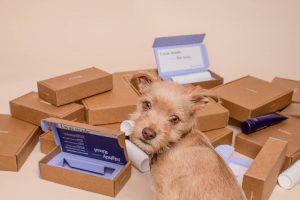Our domestic dogs are predators whose behaviour can sometimes be problematic. How do you handle this instinct every day?
The hunting instinct, what is it?
To qualify the hunting instinct, the Canine behaviour specialists speak more willingly for predatory or instinct.
Predation, a motor pattern
In dogs, predation is innate in the sense that it expresses itself without the learning needed for the dog. It is part of the dog’s motor patterns, registered in his instinct for generations. What is called a motor boss is, according to the definition of Joël Dehasse *, ” a posture, a movement, or a sequence of instinctive and self-reinforced movements. ” Always according to this behaviourist veterinarian, “trotting, gallop, pursue a moving object, point, fix an object with a low posture (like the border collie), bring back, search for a lost puppy are motor patterns. »
Predation is, therefore, an activity that gives a lot of fun to the dog. The more it practices it, the more it makes it want to indulge again and again as an irrepressible internal drive.
By the way, everything in the dog tells us that it is an animal ” cut to chase “: His musculature, his dentition and even his senses. Its vision is based on fine detection of movements. It generates hypervigilance of the dog, a dilation of his pupils, and a concentration of all his attention to jump, pursue and catch his prey.
How is the predatory instinct in a dog?
The predation behaviour composed of several sequences of behaviours (or motor patterns). Thus, a complete hunting behavioural sequence includes:
orientation,
visual fixation,
the pursuit,
the pursuit,
capturing,
The ratio of prey and/or death followed by immediate ingestion or burial for deferred ingestion.
Each of these behaviours exists independently of others, and each of them is the trigger of the following behaviour.
In the domestic dog, human genetic selection broke this predation sequence to keep only behaviours that were useful for some human activities. To do this, the man selected dogs that expressed or did not express some of these behaviours.
This is how we find ourselves nowadays with dog breeds, “specialized” lineages in one or more of these behaviours. For example, the game report has become “the specialty” of retriever dogs (Labrador, Golden Retriever …) while tracking and prosecution (sometimes followed by the killing of prey) are the typical behaviours of burrows. Shepherd dogs were selected for their ability to fix, track down and pursue livestock animals without capturing them.
When predation poses a daily problem
If the expression of the predatory instinct is very appreciated and sought after dogs who practice hunting or who work in the flock, it is often far from being the case with a family dog that does not have the opportunity to express his instinctive motor patterns.
It is unfortunately often the case when the owner of the animal did not take into account the behavioural characteristics of the breed before adopting his companion and/or that he did not properly socialize ** his dog.
Failure to have the opportunity to gather a flock of sheep, a border collie, can try to control bicycles, cars, the children of the house, and to run behind everything that is moving. Getting done it only expresses its instinct on all these inadequate targets. Which is not safe for the animal and for ” its prey”.
Some dogs will express their instinct of predation on the stuffed girls by shaking them, capable unless they do it on a real prey, killing the house cat or the floods of the neighbour.
The predation instinct can also be problematic in dogs that a strong instinct of prosecution, as is the case, including current dogs. It will then be very difficult to obtain from them the reminder in a snap of a finger and make the walks in freedom much more hazardous.
The hunting instinct how to live with?
Accept what you can not change.
That thing is clearly told, and we can not completely disappear the predation behaviours of a dog because they are anchored in him. However, it is sometimes possible to mitigate or find parades to make them less annoying on a daily basis.
If your dog does not return to the reminder
If what’s a problem for your everyday life is the fact that your dog does not come back in spite of a good reminder of you, know that there are solutions to no longer lose your dog during a full walk-in nature. Dogs that have a strong instinct of prosecution can thus ignore everything they have learned when they have prey in the collimator. What pushes them to move away from their owner, who calls them then in vain for several minutes at several hours. The dog owners who have already done the bitter experience are then trying to give up forever to the walks without fear of losing their dog again. In doing so, they also deprive it of the possibility of running and physically spending, which can be at the origin of the appearance of behavioural disorders in the animal. How to walk again continue to walk such a dog without a leash?
Locate your dog with a GPS necklace
Instead of relinquishing renouncing free walks, you can quite equip your dog with a GPS tracking collar to know at any time when it is, without any more risk of losing it. Some GPS necklaces like those offered by Chasseur.com keep moving a dog more than 10km, something to secure your walks and follow your dog’s move at any time.
Reorient the behaviour of your dog
During your outdoor walks, watch your dog. Then, when your dog stiffens and puts on the lookout, immediately turn his attention by launching a bullet, for example. On the other hand, book the games launching this particular context and proscribe them at home. Getting done, you will find the just extent between the satisfaction of its ethological need without reinforcing its over-measure. Take care to launch the ball in bushes so that it is not immediately available for the dog. Putting time to catch it will allow him not to ride in excitement and ” come back to him”, making it much more inclined to listen to you when you call it back.
If your dog continues bicycles, joggers or cars
In the locations at risk, it is obviously worth holding your dog on a leash or even muzzle your dog if he tries to capture his “prey” by biting the calves of cyclists or joggers.
For these dogs, it is also advocated to avoid strengthening this pursuit behaviour by offering their games to launch at home or, at least, to use them wisely by allowing the dog to go for your indication. It is also recommended to let the dog indulge in his instinct, in a controlled and structured manner by the owner, through activities such as tribal (for example) and to teach the dog to turn away from what interests, thanks to the learning of the indication “You leave”. Our article entitled “My dog runs after joggers and bicycles” explains how to do it.
If your dog demonstrates predation aggression
We are talking about predation aggressiveness when a dog kills prey that he continued. It can be small prey like a cat, a chicken or rodent or a greater prey like a sheep or game. If it is not possible to remove this predation behaviour, it is possible to reduce the risks by working with a competent canine behaviourist. In particular, it will be necessary to work on the strengthening of the dog’s self-control.





